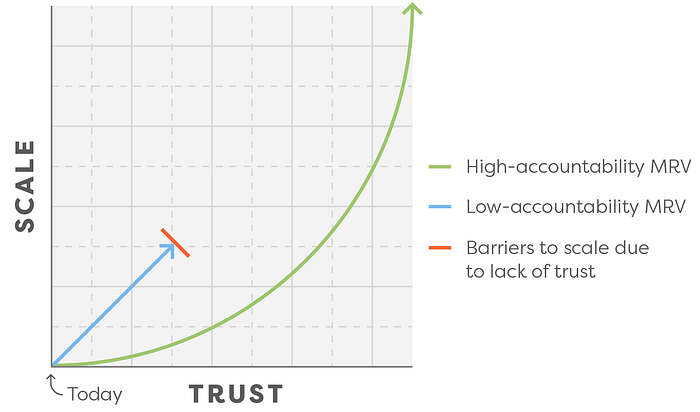
Thu Mar 07 2024 | 5 min read
A buyer’s guide to high-accountability MRV
Author

Peter Minor
Bolstered by landmark policies like the Bipartisan Infrastructure Law and the Inflation Reduction Act, the carbon removal field is making big promises. Many of these promises are focused on increasing our capacity for drawdown, and for good reason: carbon removal is an essential tool for meeting theParis Agreement goalsand avoiding the worst impacts of2ºC of warming. But scale is only part of what’s required to make these promises a reality — we also need trust.
Trust underpins the success of this field; without it, we lose two groups of constituents that are necessary to achieve gigaton scale by 2050. The first group is communities that will host carbon removal solutions. The second are taxpayers whose support can unlock massive investment of societal resources — capital, energy, human resources, and political will. Both groups need to see that carbon removal projects bring real climate and economic benefits.
To build trust in the carbon removal sector, we believe that robustmonitoring, reporting, and verification, or MRV, is a fundamental prerequisite. MRV is the process ofaccountingfor all of the emissions, energy use, environmental and public health impacts associated with a carbon removal project to determine its net climate impact. It tells us if the work was done safely and effectively, and provides receipts.
If designed properly, MRV enablesaccountabilityand thus, trust. What does this look like in practice? For MRV to be a tool for both accounting and accountability, four things must happen.
- Direct Accounting of Removals and Impacts:The best MRV protocols measure all variables associated with the project including removalsandimpacts to human health and ecosystems.
- Traceability Over Time:After measuring the removal of CO₂ from the atmosphere, monitoring stored carbon and ongoing health and ecosystem impacts is needed to establish durability and safety. Even after a project ends, impacts persist.
- Data Transparency:How project information is made available to stakeholders is just as important as measurement and monitoring of the initial collection of data. Without data transparency and accessibility, there is no accountability.
- Appropriate Incentive Structure:Verification of removals must take place within a financial incentive structure that minimizes fraud and maximizes public benefit.

We’ve developed these principles ofhigh-accountability MRVto describe what MRV could look like decades from now, in a world where gigaton scale carbon removal is a reality. In this world, robust MRV holds suppliers who are removing CO₂ from the atmosphere accountable to buyers who purchase CO₂ removal in support of corporate, national and global climate goals. It also ensures that taxpayer dollars are distributed towards the most impactful projects, and local communities that host carbon removal deployments know that public health and the environment are protected.
Defining these guiding principles now means we can identify and develop policies needed to improve carbon removal technologies and MRV protocols together — ensuring that the industry is built on pillars of both trust and scalability.
But emphasizing MRV rigor inevitably means facing off against some very difficult technical challenges. For example, collecting soil core samples to assess changes in carbon content is a manual, time consuming, and expensive process today. But this is solvable, and we’re already seeing advances in both in-field and remote sensing technology to make it cheaper and easier for farmers to realize the economic benefits of carbon removal. If we focus only on what’s possible for MRV today instead of in the future, then we’ve set the bar too low and may face disastrous long-term consequences, including loss of public trust in the field, rampant fraud, and a potential collapse of the industry.

2022 was a breakout year for carbon removal, thanks in large part to the commitments made by early purchasers. We want 2023 to be the year for high-accountability MRV.
We recognize this will be challenging, so we’ve built a tool to help:a matrix that breaks down the four principles of high-accountability MRV, all tied to specific actions that foster greater degrees of accountability. Each is contrasted with the characteristics of middling and lower examples to better clarify where improvements can be made compared to the state of play today. This tool is a first draft, which we hope to continue developing alongside organizations with similar intentions to build an effective and just carbon removal industry.
To date, procurers have been using advanced market commitments and long-term off take agreements to spur innovation. We’d like to offer up an idea: maximizing high-accountability MRV on early purchases is how buyers of carbon removal can also help kickstart trust-building for the industry early on. They can do this by adopting three simple practices:
- Emphasize accountability for communities and the public by working with suppliers to take the actions described in theMRV principles matrix,
- Select suppliers based on MRV quality, and continue pushing the boundary on expectations to incentivize continued innovation, and
- Openly acknowledge when choices are made to accept lower MRV certainty, in exchange for lower cost and complexity.
The level of public and private support for carbon removal we’re seeing today is something Carbon180 has been working towards since 2015. But we’re just starting down the path towards building an industry that can reverse two centuries of carbon emissions — and there are many opportunities to get lost along the way if we take shortcuts. High-accountability MRV is the best way to guarantee that carbon removal is an effective climate tool to secure a livable climate in which current and future generations can thrive.
Related Blogs
Add your comment here

ADDRESS
Zero Carbon One
WY 82801, United States.
New Delhi - 110016, India. Noida - 201 301, India.



© 2025 — Copyright ZeroCarbon One
Zero Carbon One LLC
Zero Decarbon One Pvt. Ltd.





















